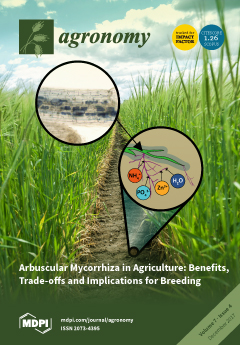While improving the efficiency at which rice plants take up fertiliser nitrogen (N) will be critical for the sustainability of rice (
Oryza sativa L.) farming systems in future, improving the grain yield of rice produced per unit of N accumulated in aboveground plant material (agronomic N use efficiency; NUE
agron) through breeding may also be a viable means of improving the sustainability of rice cropping. Given that NUE
agron (grain yield/total N uptake) is a function of harvest index (HI; grain yield/crop biomass) × crop biomass/total N uptake, and that improving HI is already the target of most breeding programs, and specific improvement in NUE
agron can only really be achieved by increasing the crop biomass/N uptake. Since rice crops take up around 80% of total crop N prior to flowering, improving the biomass/N uptake (NUE
veg) prior to, or at, flowering may be the best means to improve the NUE
agron. Ultimately, however, enhanced NUE
agron may come at the expense of grain protein unless the N harvest index increases concurrently. We investigated the relationships between NUE
agron, total N uptake, grain yield, grain N concentration (i.e., protein) and N harvest index (NHI) in 16 rice genotypes under optimal N conditions over two seasons to determine if scope exists to improve the NHI and/or grain protein, while maintaining or enhancing NUE
agron in rice. Using data from these experiments and from an additional experiment with cv. IR64 under optimum conditions at an experimental farm to establish a benchmark for NUE parameters in high-input, high yielding conditions, we simulated theoretical potential improvements in NUE
veg that could be achieved in both low and high-input scenarios by manipulating target NHIs and grain protein levels. Simulations suggested that scope exists to increase grain protein levels in low yielding scenarios with only modest (5–10%) reductions in current NUE
agron by increasing the current NHI from 0.6 to 0.8. Furthermore, substantial scope exists to improve NUE
veg (and therefore NUE
agron) in high-yielding scenarios if maintaining current grain protein levels of 7.3% is not essential.
Full article





